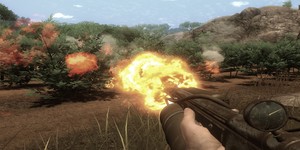
There are other strangely incongruous writing quirks. The game has a bizarre obsession with social media. Your main antagonist, Pagan Min, loves Twitter and takes selfies, while the aforementioned DJ does a skit about twerking that the game's car radio repeats about a thousand times. I don't think this stuff is unworkable by nature, but it feels like the game is ticking "cultural relevance" boxes it doesn't need to. This attention seeking trait is problematic in characterisation as well. While Pagan Min himself is a fantastic baddie, most other characters are defined by a single trait exaggerated to the point of caricature, like the bible-quoting arms-dealer Longinus, or the British stoner "Guru's" Yogi and Reggie.
Oh goodness, I said I was going to get this negative stuff out of the way quickly, didn't I? Clearly it irked me more than I realised. Anyway, narrative quibbles aside, the main difference between Far Cry 3 and 4 is the nature of the playground it provides. Kyrat's mountainous landscape means verticality plays a far more prominent role in how you approach navigation and combat. Almost every surface you encounter is either sloped or sheer, which means it's very easy to find high ground from which to scout enemy bases. If you're the sniping type, then welcome to paradise. Here's your rifle.
The tools you need to take advantage of this rugged environment are available from the get-go. A grappling hooks lets you clamber vertical rock-faces that would otherwise obstruct your path, although only pre-designated points though, while is slightly disappointing. Meanwhile the wingsuit from Far Cry 3 can be purchased within that initial hour, enabling a speedy escape from a mountaintop fracas. You don't have it all your way. The skies are patrolled by huge eagles that will tear a chunk from your arm if you don't stay vigilant, while alerted enemy bases can call in helicopter support.
Another significant inclusion is the ability to fire weapons while driving vehicles. This may sound like a small tweak, but it has a pretty substantial effect on how you play the game. In addition to making it far easier to defend yourself when ambushed on the road, now you can chase down enemy vehicles and convoys rather than waiting for them to come to you. Far Cry 4 is all about adding greater flexibility to the game's systems, giving the player more options in how to approach it.
Complementing this is a far greater range of activities to participate in alongside the outpost clearing and animal hunting. These are divided into two groups. Side-missions such as hostage rescues, assassination missions, survival challenges and races award you with experience points and specific skill unlocks. Then there are dynamic events that occur on the road, such as the appearance of a military truck filled with weapons that you can choose to destroy or hijack, or an encounter with an enemy courier who you can chase through the hilly landscape. These dynamic events reward you with "Karma" points which unlock special weapons and the ability to call in Golden Path reinforcements whenever you please.
It's a vast amount of capital-C Content, which I criticised Assassin's Creed Unity for splurging all over Revolutionary Paris. The difference here is that Far Cry gives you incentives to explore everything it has to offer, and for the most part its attractions and distractions tie well into Kyrat's fiction. Also, it's fun simply because Far Cry gets the basic mechanics right. Movements is slick, gunplay is punchy, vehicles are easy to drive but feel weighty when you're behind the wheel (crashing with any force will cause Ajay to fall forward against the dashboard, one of many little embellishments that Far Cry does so well). Everything you do, from climbing up cliffs to skidding along the ground when you crouch while running, is presented in a way that is satisfying in feedback and practical in function.
A couple of other points I should mention before we wrap up. Although I found the campaign's narrative tone to be unpalatable at times, there's little wrong with the central storyline in terms of play. By and large the missions offer you the same range of options as the game does in general. Even when it nudges you to do something in a specific way, such as covering a comrade with sniper fire while occupying an airfield, it rarely forces you into that role. Furthermore, there are a few missions which take you beyond Kyrat itself, either up the snowy peaks of the Himalayas proper, or into the mythical land of Shangri-La, the latter of which is a dazzling display of virtual artistry.
Finally, aside from the campaign missions, the whole of Kyrat can be explored cooperatively, with your friend assuming the role of the unpleasantly named Hurk. Far Cry is a far more natural fit for co-op fun than Assassin's Creed, what with its dynamic outpost-assaults, pilotable vehicles and watertight controls. The fact that it isn't restricted to specific missions is also a big help. Whether you approach the game as a duo of stealth masters, or a pair of buffoons who couldn't sit on an elephant the right way round, you'll almost certainly have fun scooting about Kyrat together.
The worst you could say about Far Cry 4 is that it isn't a very brave sequel. Then again it doesn't need to be. Far Cry 3 did all the hard work, and the changes which 4 applies are cleverly thought out extensions of what made 3 such a riot. The result is easily the most entertaining shooter I've played this year, and the most fun I've had with an elephant since I was banned from visiting Chester Zoo. (One of those statements is false).The Kyrati people might have an odd sense of humour, but you won't regret adding a trip to the Himalayas to your Christmas list.
Oh goodness, I said I was going to get this negative stuff out of the way quickly, didn't I? Clearly it irked me more than I realised. Anyway, narrative quibbles aside, the main difference between Far Cry 3 and 4 is the nature of the playground it provides. Kyrat's mountainous landscape means verticality plays a far more prominent role in how you approach navigation and combat. Almost every surface you encounter is either sloped or sheer, which means it's very easy to find high ground from which to scout enemy bases. If you're the sniping type, then welcome to paradise. Here's your rifle.
The tools you need to take advantage of this rugged environment are available from the get-go. A grappling hooks lets you clamber vertical rock-faces that would otherwise obstruct your path, although only pre-designated points though, while is slightly disappointing. Meanwhile the wingsuit from Far Cry 3 can be purchased within that initial hour, enabling a speedy escape from a mountaintop fracas. You don't have it all your way. The skies are patrolled by huge eagles that will tear a chunk from your arm if you don't stay vigilant, while alerted enemy bases can call in helicopter support.
Another significant inclusion is the ability to fire weapons while driving vehicles. This may sound like a small tweak, but it has a pretty substantial effect on how you play the game. In addition to making it far easier to defend yourself when ambushed on the road, now you can chase down enemy vehicles and convoys rather than waiting for them to come to you. Far Cry 4 is all about adding greater flexibility to the game's systems, giving the player more options in how to approach it.
Complementing this is a far greater range of activities to participate in alongside the outpost clearing and animal hunting. These are divided into two groups. Side-missions such as hostage rescues, assassination missions, survival challenges and races award you with experience points and specific skill unlocks. Then there are dynamic events that occur on the road, such as the appearance of a military truck filled with weapons that you can choose to destroy or hijack, or an encounter with an enemy courier who you can chase through the hilly landscape. These dynamic events reward you with "Karma" points which unlock special weapons and the ability to call in Golden Path reinforcements whenever you please.
It's a vast amount of capital-C Content, which I criticised Assassin's Creed Unity for splurging all over Revolutionary Paris. The difference here is that Far Cry gives you incentives to explore everything it has to offer, and for the most part its attractions and distractions tie well into Kyrat's fiction. Also, it's fun simply because Far Cry gets the basic mechanics right. Movements is slick, gunplay is punchy, vehicles are easy to drive but feel weighty when you're behind the wheel (crashing with any force will cause Ajay to fall forward against the dashboard, one of many little embellishments that Far Cry does so well). Everything you do, from climbing up cliffs to skidding along the ground when you crouch while running, is presented in a way that is satisfying in feedback and practical in function.
A couple of other points I should mention before we wrap up. Although I found the campaign's narrative tone to be unpalatable at times, there's little wrong with the central storyline in terms of play. By and large the missions offer you the same range of options as the game does in general. Even when it nudges you to do something in a specific way, such as covering a comrade with sniper fire while occupying an airfield, it rarely forces you into that role. Furthermore, there are a few missions which take you beyond Kyrat itself, either up the snowy peaks of the Himalayas proper, or into the mythical land of Shangri-La, the latter of which is a dazzling display of virtual artistry.
Finally, aside from the campaign missions, the whole of Kyrat can be explored cooperatively, with your friend assuming the role of the unpleasantly named Hurk. Far Cry is a far more natural fit for co-op fun than Assassin's Creed, what with its dynamic outpost-assaults, pilotable vehicles and watertight controls. The fact that it isn't restricted to specific missions is also a big help. Whether you approach the game as a duo of stealth masters, or a pair of buffoons who couldn't sit on an elephant the right way round, you'll almost certainly have fun scooting about Kyrat together.
The worst you could say about Far Cry 4 is that it isn't a very brave sequel. Then again it doesn't need to be. Far Cry 3 did all the hard work, and the changes which 4 applies are cleverly thought out extensions of what made 3 such a riot. The result is easily the most entertaining shooter I've played this year, and the most fun I've had with an elephant since I was banned from visiting Chester Zoo. (One of those statements is false).The Kyrati people might have an odd sense of humour, but you won't regret adding a trip to the Himalayas to your Christmas list.
-
Overall90 / 100


MSI MPG Velox 100R Chassis Review
October 14 2021 | 15:04

![Far Cry 4 Review [TUESDAY] Far Cry 4 Review](http://images.bit-tech.net/content_images/2014/11/far-cry-4-review/farcry6-614x345.jpg)
![Far Cry 4 Review [TUESDAY] Far Cry 4 Review](http://images.bit-tech.net/content_images/2014/11/far-cry-4-review/farcry7-614x345.jpg)
![Far Cry 4 Review [TUESDAY] Far Cry 4 Review](http://images.bit-tech.net/content_images/2014/11/far-cry-4-review/farcry8-614x345.jpg)
![Far Cry 4 Review [TUESDAY] Far Cry 4 Review](http://images.bit-tech.net/content_images/2014/11/far-cry-4-review/farcry9-614x345.jpg)
![Far Cry 4 Review [TUESDAY] Far Cry 4 Review](http://images.bit-tech.net/content_images/2014/11/far-cry-4-review/farcry10-614x345.jpg)








Want to comment? Please log in.